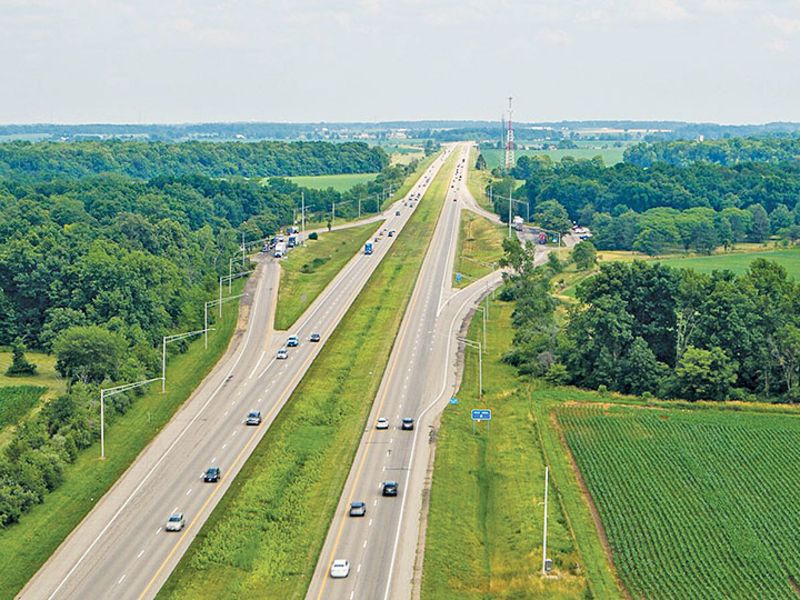
State, county and municipal government fleets in Ohio, as well as private citizens who volunteer to participate, are expected to add hundreds more connected vehicles — specially equipped to test new advanced driver-assistance systems — along a 35-mile stretch of “smart” highway in central Ohio called the 33 Smart Mobility Corridor.
Efforts are underway to quadruple the number of test vehicles interacting with each other and with the infrastructure along U.S. Route 33, said Sue Bai, chief engineer at the Honda Research Institute and project lead for the 33 Smart Mobility Corridor.
“We’re very excited to see more cars coming on board,” she said in a phone interview. “With government fleets coming online, we expect at least 600 more connected vehicles.”
Honda has more than 200 specially equipped, connected Honda and Acura vehicles deployed in the area, she said.
American Honda Motor Co. is a major partner and the most active automaker participating in the 33 Smart Mobility Corridor. Other participants include The Ohio State University, as well as other private- and public-sector entities.
Much of the corridor was originally funded with a federal grant, said Luke Stedke, a spokesman for DriveOhio. Launched in 2018, DriveOhio is the state’s clearinghouse for smart mobility projects, with support from the state Department of Transportation.
For testing purposes, connected vehicles are retrofitted with antennas to navigate and to broadcast information; an on-board computer to interpret and communicate data; a head-up display and speaker to provide the driver with information, as well as visual and audio alerts.
Honda retrofits its own connected vehicles that participate in testing. The state retrofits state, county and local-government vehicle fleets and, according to DriveOhio, will do the same for privately owned vehicles once they begin to participate.
A higher density of connected vehicles makes testing more realistic, Bai said. “We need to design something today that will work in the future environment.”
Stedke said in a phone interview that plans to add local-government fleet vehicles are still in the works, but that the vehicles should start coming on line soon.
He said the organization hasn’t started recruiting private citizens to participate in testing, but that’s expected to happen in the second quarter of 2022. It plans to recruit up to 400 or so.
Some features Honda is testing along the 33 Smart Mobility Corridor include:
Situational Awareness — A head-up display shows the relative position of other connected vehicles and connected pedestrians near the driver.
Signal Countdown Timer — As a vehicle approaches a connected intersection, the driver receives a red-light countdown, allowing the driver to adjust the vehicle speed to cross the intersection when the traffic signal turns green. Maintaining a steady speed with fewer stops can improve energy efficiency.
Lane Speed Monitoring — The network of connected vehicles is mapped to indicate the traffic flow for each lane. The application allows the driver to select the lane with the least congestion, saving time and energy.
Sudden Braking Alert — An obstacle on the road causes drivers to begin hard braking to avoid a collision. Connected vehicles closest to the obstacle communicate a warning to approaching vehicles, allowing them to slow down gradually and reduce the potential for a collision with other vehicles.
In addition to safety and convenience, Honda’s Bai said many of the advanced driver-assistance features being tested are aimed at greater fuel efficiency.
The corridor runs from the Columbus suburb of Dublin to the city of East Liberty via Marysville, Ohio — the Japanese automaker’s manufacturing hometown in the U.S. Honda started making motorcycles there in 1979, followed by cars starting in 1982.
The Ohio Department of Transportation and local governments have equipped the highway with fiber optic cable and roadway sensors that link researchers and traffic monitors with data generated from in-vehicle and roadside communications units, according to DriveOhio.
In addition to the highway, and the connected vehicles using the corridor, parts of Honda’s manufacturing campus and the traffic infrastructure in Marysville — such as signs and traffic lights — are equipped with cameras and other technology.
For example, a smart traffic signal, with cameras facing all directions, can warn a connected vehicle approaching an intersection that a pedestrian is about to cross the street, even though the pedestrian is out of the driver’s sight, around a blind corner.

